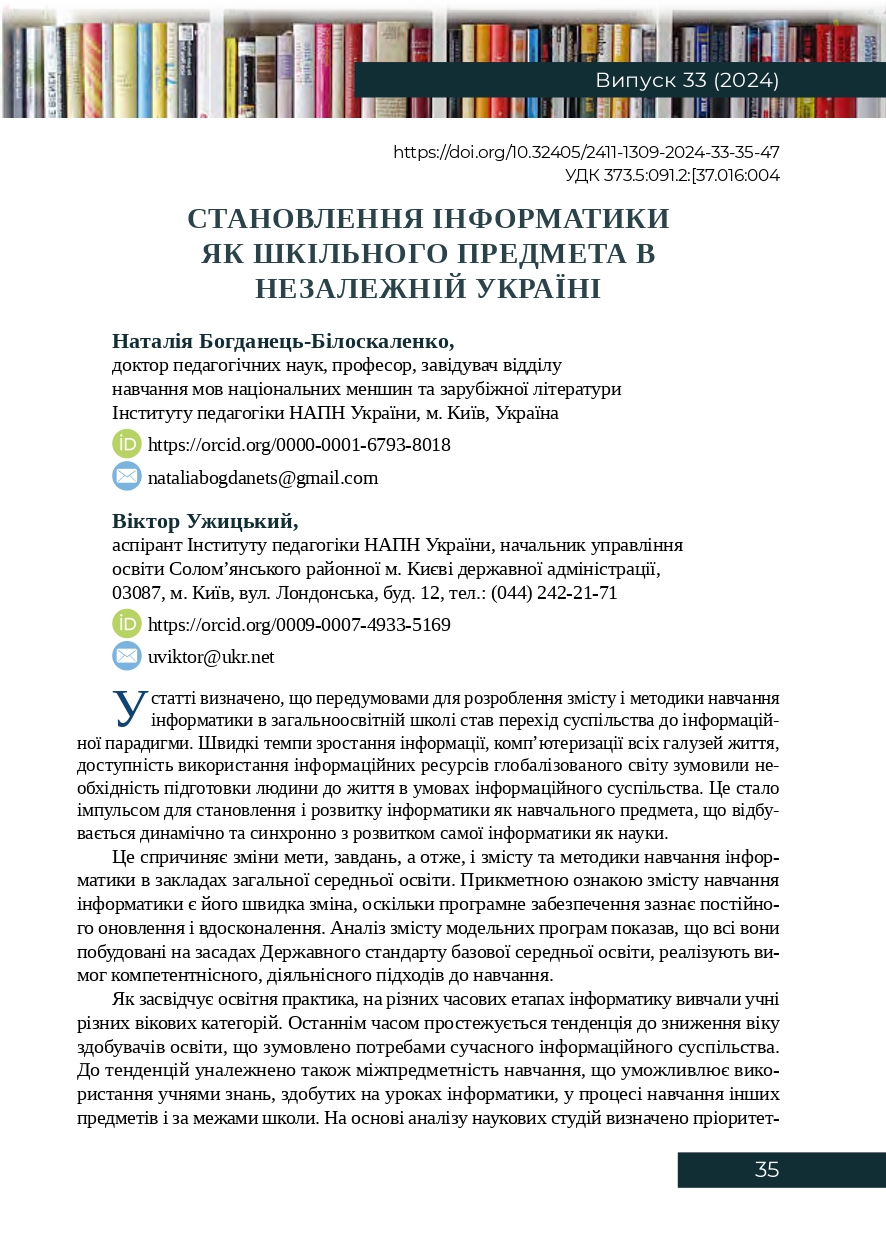ESTABLISHMENT OF COMPUTER SCIENCE AS A SCHOOL SUBJECT IN INDEPENDENT UKRAINE

Published 2024-12-31
Keywords
- computer science,
- school subject,
- informatization of society,
- content of education,
- trends in computer science education
How to Cite
Copyright (c) 2025 Наталія Богданець-Білоскаленко, Віктор Ужицький

This work is licensed under a Creative Commons Attribution-NonCommercial-ShareAlike 4.0 International License.
Abstract
The article determined that the transition of society to the information paradigm became the prerequisite for the development of the content and methodology of teaching informatics in secondary schools. The rapid pace of information growth, the computerization of all spheres of life, and the availability of the use of information resources in the globalized world made it necessary to prepare a person for life in the conditions of the information society. This became an impetus for the formation and development of informatics as an educational subject, which occurs dynamically and synchronously with the development of informatics itself as a science.
This causes changes in the purpose, tasks, content and methods of teaching informatics in general secondary education institutions. A notable feature of the content of computer science education is its rapid change, as the software is constantly updated and improved. The analysis of the content of the model curricula showed that all of them are built on the basis of the State Standard for Basic Secondary Education and implement the requirements of competence-based, activity-based approaches to education.
As evidenced by educational practice, students of different age categories studied informatics at different time stages. Recently, there has been a trend towards a decrease in the age of education seekers, which is due to the needs of the modern information society. Interdisciplinary learning is also part of the trends, which makes it possible for students to use the knowledge acquired in computer science classes in the process of learning other subjects outside of school. On the basis of the analysis of scientific studies, the priority functions of computer science in general secondary education institutions were determined: worldview, cognitive, developmental, educational, and reflective, which is due to the integrative nature of the content of the subject, its purpose and tasks.
Computer science as a school subject is aimed at expanding and deepening the knowledge, abilities and skills necessary for successful studies, further professional activities, and the development of students’ outlook. Markers of successful learning of informatics are students’ ability to study, acquire information, self-develop, and self-realize in the conditions of the information society.
Downloads
References
- Биков, В.Ю. та ін. (1994). Концепція інформатизації освіти. Рідна школа, 11, 26–29.
- Биков, В.Ю. та ін. (2019). Розвиток теоретичних основ інформатизації освіти та практична реалізація інформаційно-комунікаційних технологій в освітній сфері України. Житомир : ЖДУ ім. І. Франка.
- Глушак, О.М. (2013). Інформаційна культура як складова професійної підготовки майбутніх фахівців. У Матеріали ІІІ щорічної науково-практичної конференції «Дослідження молодих учених у контексті розвитку сучасної науки» (18 квітня 2013 р., м. Київ). https://elibrary.kubg.edu.ua/id/eprint/1911/1/Glushak_IS_konf.pdf
- Гуржій, А.М., Карташова Л.А., Лапінський, В.В. (2018). Інформатизація загальної середньої освіти в Україні. https://lib.iitta.gov.ua/id/eprint/714609/7/08.pdf
- Державний стандарт базової середньої освіти. (2020). Постанова Кабінету Міністрів України від 30 вересня 2020 р. № 898. https://zakon.rada.gov.ua/laws/show/898-2020-%D0%BF#n16.
- Млавець, Ю.Ю. (2021). Методика навчання інформатики (конспект лекцій для студентів факультету суспільних наук). Ужгород: ДВНЗ УжНУ.
- Морзе, Н.В. (2004). Методика навчання інформатики (у 3 частинах). Навчальний посібник. Київ: Навчальна книга.
- Півняк, Г.Г. та ін. (уклад.). (2010). Тлумачний словник з інформатики. Дніпропетровськ: Національний гірничій університет.
- Середа, Х.В. (1994). Концепція інформатизації освіти: структурно-змістовий аналіз. https://lib.iitta.gov.ua/id/eprint/723227/1/abstracts_collection_2020-41-42.pdf
- Стрілецька, Н. М. (2014). Методика навчання інформатики (у початковій школі): навчально-методичний посібник. Чернігів : Чернігівський національний педагогічний університет імені Т.Г. Шевченка.
- Тлумачний словник української мови. https://slovnyk.ua/index.php?swrd=%B2%CD%D4%CE%D0%CC%C0%D2%C8%CA%C0
- Bykov, V.Iu. at al. (1994). Kontseptsiia informatyzatsii osvity. Ridna shkola, 11, 26–29. (in Ukrainian).
- Bykov, V.Iu. at al. (2019). Rozvytok teoretychnykh osnov informatyzatsii osvity ta praktychna realizatsiia informatsiino-komunikatsiinykh tekhnolohii v osvitnii sferi Ukrainy. Zhytomyr : ZhDU im. I. Franka. (in Ukrainian).
- Hlushak, O.M. (2013). Informatsiina kultura yak skladova profesiinoi pidhotovky maibutnikh fakhivtsiv. In Materialy III shchorichnoi naukovo-praktychnoi konferentsii «Doslidzhennia molodykh uchenykh u konteksti rozvytku suchasnoi nauky» (April 18, 2013, Kyiv). https://elibrary.kubg.edu.ua/id/eprint/1911/1/Glushak_IS_konf.pdf (in Ukrainian).
- Hurzhii, A.M., Kartashova L.A., Lapinskyi, V.V. (2018). Informatyzatsiia zahalnoi serednoi osvity v Ukraini. https://lib.iitta.gov.ua/id/eprint/714609/7/08.pdf (in Ukrainian).
- Derzhavnyi standart bazovoi serednoi osvity. (2020). Postanova Kabinetu Ministriv Ukrainy vid 30 veresnia 2020 r. № 898. https://zakon.rada.gov.ua/laws/show/898-2020-%D0%BF#n16 (in Ukrainian).
- Mlavets, Yu.Iu. (2021). Metodyka navchannia informatyky (konspekt lektsii dlia studentiv fakultetu suspilnykh nauk). Uzhhorod: DVNZ UzhNU. (in Ukrainian).
- Morze, N.V. (2004). Metodyka navchannia informatyky (in 3 parts). Navchalnyi posibnyk. Kyiv: Navchalna knyha. (in Ukrainian).
- Pivniak, H.H. at al. (comp.). (2010). Tlumachnyi slovnyk z informatyky. Dnipropetrovsk: Natsionalnyi hirnychii universytet. (in Ukrainian).
- Sereda, Kh.V. (1994). Kontseptsiia informatyzatsii osvity: strukturno-zmistovyi analiz. https://lib.iitta.gov.ua/id/eprint/723227/1/abstracts_collection_2020-41-42.pdf (in Ukrainian).
- Striletska, N. M. (2014). Metodyka navchannia informatyky (u pochatkovii shkoli) : navchalno-metodychnyi posibnyk. Chernihiv: Chernihivskyi natsionalnyi pedahohichnyi universytet imeni T.H. Shevchenka. (in Ukrainian).
- Tlumachnyi slovnyk ukrainskoi movy. https://slovnyk.ua/index.php?swrd=%B2%CD%D4%CE%D0%CC%C0%D2%C8%CA%C0 (in Ukrainian).
